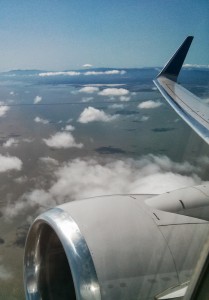A Better Airfare-Booking Model Remains Up In The Air
 If you want to get people to shut up about the indignities of domestic air travel these days, ask them about the joys of booking their airfares.
If you want to get people to shut up about the indignities of domestic air travel these days, ask them about the joys of booking their airfares.
The airlines charge all those extra fees, the booking sites don’t list them or only list some of them, and there’s always the nagging worry that you missed a better fare two weeks, two days or two hours ago.
Many of those problems start with a three-level scheme vaguely reminiscent of state-regulated alcohol distribution. You can book direct at an airline’s site–but if you want to compare fares, you need to shop elsewhere, and in that case your query typically must pass through a “Global Distribution System” (GDS) network and then one online travel agent (OTA) or another. Some 60 percent of ticket sales go through those third parties.
Airlines aren’t too fond of GDSes, thanks to the commissions they exact and their troubles displaying much more than plain fares. Many customers, in turn, resent discovering late in the booking process that an initially attractive flight comes with extra charges.
To fix this, the airlines are pushing an XML (Extensible Markup Language) system called “New Distribution Capability” (NDC) that would publish those ancillary fees with better descriptions of basic and add-on services–then let them present offers personalized for travelers willing to ID themselves.
In the bargain, a standards-based market could give GDSes new competition and drive down their per-segment fees.
Those aren’t universally seen as desirable goals–as the hour-long debate between airline-industry, travel-site and consumer representatives that I moderated on Wednesday for the Advisory Committee to the Congressional Internet Caucus reminded me.
GDSes, OTAs and other resellers say NDC will give airlines too much power–leading to eBay-esque fluctuations in fares and frequent travelers getting gouged for their perceived price tolerance. They don’t seem to mind adding ancillary fees to their menus but balk at presenting personalized offers.
Many passengers, in turn, are still sore over having to pay extra for what used to be free without getting obvious corresponding benefits in return. (Alaska Airlines provided a rare exception when it coupled a new baggage-service guarantee to its checked-baggage fee.)
Since the airlines want the Department of Transportation to approve NDC, as codified in the International Air Transport Association’s Resolution 787, this has become a Washington policy fight as well.
Wednesday’s discussion didn’t resolve those issues but did leave me with ideas about how both airlines and flight-search sites could upgrade things for their customers.
First, the airlines: If they want to show us how their vision of the future can work, they could do a better job of demonstrating it on their own sites.
There, the upside of personalized deals remains largely hypothetical, with customized offers largely confined to targeted e-mail offers. The best you can say is that their record suggests fears of frequent customers getting jobbed are overblown: The rare times that’s happened, it’s been by mistake, and there’s also the high probability of getting smacked down by the Department of Transportation for deceptive conduct.
The airlines would also do well to catch up to the superior search capabilities of flight-search sites. I look up itineraries on Kayak or Hipmunk when I know what airline I’ll fly because they make it easier to filter out inconvenient connections and times.
The GDSes and OTAs, meanwhile, have their own work to do–not even Google’s entry into the market has made them much smarter.
For instance, they don’t have to act as if they have no idea what the airlines charge for a checked bag or seat reservation.
Most of these fees aren’t horribly complex (Spirit’s fees may require a heroic effort to avoid, but they’re still vastly simpler than Ryanair’s web of seasonally-varying surcharges), and the better OTAs list them already. They just need to factor them into pricing estimates, preferably with something more obvious than Kayak’s small-type “Add baggage” link to calculate checked-luggage costs.
These sites could also try trusting travelers to know their frequent-flier status or airline credit cards. Those are the two simplest ways to evade ancillary fees, but these retailers make no attempt to store them in their preferences. Market-leading Expedia may be the worst: It invites you to set a meal preference but asks nothing about status.
(These sites could collect frequent-flier data automatically, but the airlines have a habit of quashing third-party attempts to scrape this information.)
The history of the Internet’s erasure of middlemen suggest the GDSes have the weaker hand. But this isn’t like other case studies of disintermediation; most of the actors pushing this change aren’t fresh-faced startups but incumbents with decades of tenure and a legacy of customer mistrust to overcome. It looks like any comprehensive upgrade of this market will have a long takeoff roll.








